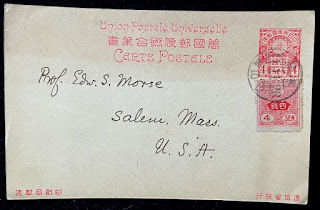 |
| 佐々木忠次郎からエドワード・S・モース |
For whatever the reason, Chujiro Sasaki uses Roman numeral to denote month of the year. In this instance, he uses "XI" for November: 'Tokyo 26. XI. 1922' for this postcard sent to Edward Sylvester Morse. It appears Morse had sent him an article on soft-shell clams and a work relating to archery, a sequel to his 1885 "Ancient and Modern Methods of Arrow Release."
Tokyo 26. XI. 1922
Dear Prof.
Today I have reveived your two papers -
1. An abnormal shell of Mya arenaria
2. Additional notes on arrow release - and read them with great interests. I should say much thanks to your kindness and am glad to hear your everlasting scientific works.
Hon. Prof. C. Sasaki
Agric Coll. Tokyo
Imp. Univ.
Tokyo, Japan
 |
| Ancient and Modern Methods of Arrow Release |
Below is an extract from that work:
"In 1885 I published, in the Proceedings of the Essex Institute, a paper entitled "Ancient and Modern Methods of Arrow Release." From the difficulty I found in ascertaining the various attitudes of the hand in drawing the bow I began to realize that no one had made a study of the subject and that I had made a discovery."
An Abnormal Shell of Mya Arenaria, 1922, Nautilus, volume 36, pp. 28-30.
Below is an extract from that work:
"The many deformations in the shells of Mollusca have often been described and figured and their causes easily explained. Some of these deformations have been due to injuries to the shell in its early stages, others are due to an arrest of development — atrophy, or an access of growth — hypertrophy, as are the usual causes of malformations among the higher animals and man. In shells these malformations generally consist in the case of gasteropods of the whorls being separated, elongation of the spire, extra knobs, spines, ribs or keels or simple monstrosities; reversed twirls of the spire in dextral shells, supernumerary teeth in the aperture. These and other modifications of the shell are readily understood. I now present an example of an abnormal growth which has so far been inexplicable to me, and it is hoped that some reader of the Nautilus will solve the problem. Recently I received the right valve of the common clam, Mya arenaria, from my friend Major John M. Gould, who received it from Levi C. Carter of Loudville, Maine, who got it at Marsh Island, midway between the Kennebec and Penobscot Rivers."
From these writings, it becomes evident that Morse continued his lifelong research on various subjects until his death in 1925.


No comments:
Post a Comment